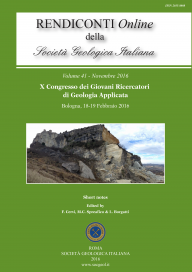
Hydrogeological investigation of Pietra di Bismantova slab and surrounding slope deposits (northern Apennines, Italy)
Manuela Deiana (a), Federico Cervi (b), Catherine Bertrand (c) & Francesco Ronchetti (a)
(a) Department of Chemical and Geological Sciences, University of Modena and Reggio E., Via Campi, 103, 41125, Modena, Italy. E-mail: francesco.ronchetti@unimore.it
(b) Department of Civil, Chemical, Environmental, and Materials Engineering, University of Bologna, Viale Risorgmento, 2, 40136, Bologna, Italy.
(c) UMR6249 Chrono-Environnement—University of Bourgogne Franche-Comté, 16 route de Gray, 25030, Besançon cedex, France.
DOI: https://doi.org/10.3301/ROL.2016.112
Volume: 41/2016
Pages: 135-138
Abstract
The recent application of hydrochemistry to unstable slopes reveals the contribution of this technique to better understand hydrological processes, water rock interaction and to outline groundwater flow paths.
The aim of this short note is to present results from two years of semi-continuous monitoring (discharge, EC, temperature) of two springs (Eremo and F.Cornia spring) flowing along the SE slope of Bismantova fractured slab, in the stable and unstable portion of the slope respectively. Both springs follow the precipitation pattern with the increase of discharge and decrease of temperature as consequence of rainfall recharge; moreover the increase of EC seems to suggest interaction beetween groundwater and mineral phases hosted along fractures of the slab. Using chemical results a first inverse modeling with PHREEQC have been performed in order to identify the interaction between water infiltrating in host-rock and mineral phases, as well to reconstruct geochemical evolution of groundwater from the upward stable portion to the downward unstable portion of the slope.
Keywords
Get Full Text